
Library Mission Statement
The Sayville Library, as part of our community’s educational system, is dedicated to providing, on equal terms, service to all individuals and groups of every age. The Library’s primary function is to collect, classify and disseminate information. Our objective is to provide and service a collection of expertly selected books and other materials, which aid the individual in the pursuit of education, information or research, and in the creative use of leisure time.
Our Values
We value excellence in all we do, including public service, staff relations, programs and collections, facilities management and financial stewardship. We encourage all employees’ collaboration and input.
About the Library
The Sayville Library is a Public Library that serves the communities of Sayville and West Sayville. We are a School District Library which means the boundaries of the library district are contiguous with the Sayville School District. The Library is chartered by the New York State Department of Education. The Library is an independent government agency overseen by a publicly elected five member Board of Trustees. Our budget is presented to District residents by the Library Board and granted by an annual vote of district residents. The Library Board hires a Library Director who is responsible for library operations and future planning. Library Board Meetings are open to the public.
History of SAYVILLE LIBRARY, 88 Greene Avenue: The first public library in Sayville was organized by St. Ann's Episcopal Parish Guild in 1880; it was housed on the second floor of the Willet Green building at the northeast corner of Main Street and Greene Avenue. The library was non-denominational and its stated object was to "furnish healthful, attractive and profitable entertainment for the young men of the village, and thus draw them away from or prevent them from falling into evil associations". It had 900 books in addition to many magazines and other periodicals. Although it received favorable comments at the time, it did not survive. The Reverend John H. Prescott, who had been in charge of both St. Ann's in Sayville and St. Paul's in Patchogue, was relieved of his Patchogue duties on January 1, 1884; this separation led to a strain on St. Ann's finances and it made known that it was no longer able to support the operation. Three decades later, at the call of the Editor's wife, Mrs. Lena Hoag, 30 ladies came together at The Suffolk County News office on March 8, 1914 and organized the Women's Village Improvement Society; their aim was to work together for better conditions in the Village. Member Mrs. Margaret Brush offered the group two rooms on the second floor of her building at 16 South Main Street as their meeting place. Their biggest and most immediate project was to establish a Public Library. The members started by contacting some of the leading publishing houses and also the State for possible financial aid. As required by law, on July 20, 1914 a Library Association was formed. This had to be separate and distinct from any other group (including the WVIS) and was needed to obtain a charter, transact business, hold property, and to draw an appropriation from the State to purchase "approved books". On August 12 and 13 the Association held a Bazaar at the Opera House, offering diverse items for sale as well as entertainment; profits of over $500 were for the Library Fund. Mrs. Brush then offered, at no cost, another large room over Otto's Meat Market as the library reading room. Merchants provided furnishings, contractors provided free labor and other townspeople gave books, furniture and money. A list of books to be ordered had been submitted to State censors and, with few exceptions, returned approved. This procedure was necessary to receive the $100 that the State would give free libraries. The Library opened on October 14th; the initial plan was to have it open for two hours three afternoons and two evenings (i.e.10 hours) a week. For several weeks, it would operate as a reading room only until the 500 volumes already on hand and others ordered had arrived, been catalogued and prepared for distribution. The first books were borrowed on November 14th and at the end of the first eight months, there were 110 paid members of the Library Association, 558 subscribers, 1,933 volumes on the shelves, 13 newspapers and magazines on the tables and 13,508 books had been borrowed. Average running expenses for the year had been $150 with $100 spent for books matched by the State. However, it was anticipated that expenses the forthcoming year might be significantly higher, $450, which would mean a total levy on the School District of $200. In 1918, the Library received as a gift the 3,000 volume collection of Dr. George R. Brush which included various reference, travel and valuable out-of-print volumes. Thereafter, the Organization grew rapidly and lack of space became a problem for both books and subscribers. In January 1918, Ida Gillette gave the Library the deed to a 75’ x 125’ lot on the east side of Gillette Avenue for construction of a new building, which was north of but adjacent to her own residence. However, raising the money to build it proved difficult so on November 1, 1923, the Library Association voted to purchase the Reuben Edwards Homestead on South Main Street for $10,000. (The Brush Building still stands; it is now the home of Vanity Fair Salon.)
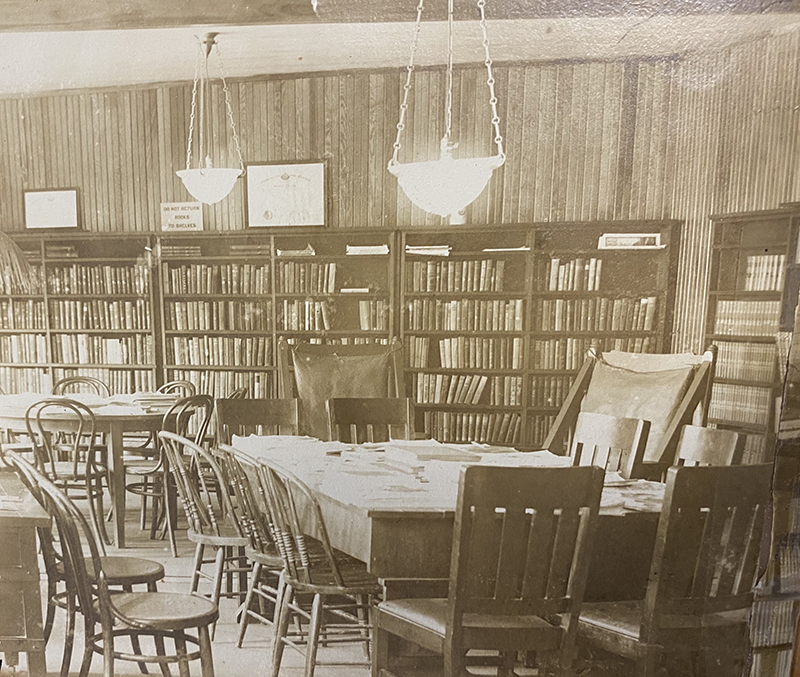
Early Sayville Library (1900)
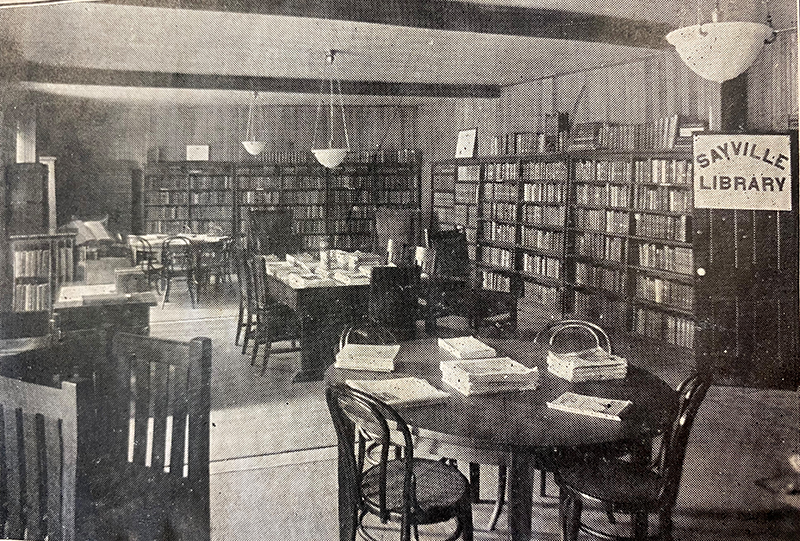
Library, 2nd Floor, Brush Block, November 14,1924
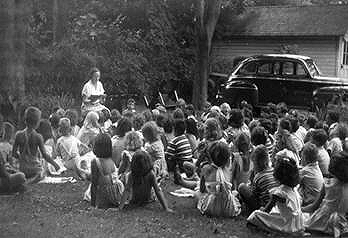
Elinor Haff reads to youngsters on back lawn, 1949
The renovated and enlarged Sayville Library celebrated with an Open House for the public on January 29, 1955. The original building, re-arranged, encompassed a larger adult reading room, a research/reference room, and stack room while down a short staircase, the new addition had a new foyer and circulation desk, the children's room and an office for the Librarian and her staff. Elinor Haff held a firm belief that a public library was more than the circulation of books. Consequently, she initiated musical recitals and worked closely with other arts groups, notably the Wet Paints Studio Group and the Sayville Musical Work Shop, integrating them into the Library's programs. In February 1955, she also began writing a weekly column, "News of the Sayville Library", for The Suffolk County News which highlighted activities, provided statistical reports of progress and noted new book arrivals and donors which helped stimulate public interest in the organization. In 1958, hours of operation were increased from 30 to 55 hours a week to accommodate both local high-school students. who were on split sessions, and Adelphi College (in Old '88) whose library was yet to be established. In 1960, Talking Books were introduced and circulated free to members of the community who met the criteria for use.
By 1960, a dramatic population increase had again brought a space problem; developers were attracting many more people to the Village. Opening hours were increased to 62 1/2 hours, one of only two libraries in the County with such lengthy availability. The State negated a possible branch library in the soon to be abandoned Tyler Avenue School (branch libraries should be at least six miles from the parent). However, Elinor Haff convinced the District School Board that expansion was necessary. At a public hearing on June 25, 1964, attendees were told that the second floor of the old building could not be used because it would not support the weight of all of the books, but that the $290,000 cost of a new building would be paid off from a 20 year bond issue. Sayville had also applied for a Federal Grant that, if approved, would cut that cost by $72,500. Although the bond issue wasapproved by voters on July 14, 1964, the Federal grant was not received until April 23, 1965, at which time the Trustees proceeded with construction bids. Following the submission of bids, the Library re-located temporarily to the old Telephone Building on Railroad Avenue which had two 70’ x 30’ floors and a full basement. Although opening hours remained the same for borrowers, supplementary activities had to be significantly curtailed for a year while demolition of the old homestead and construction of the new building were underway.
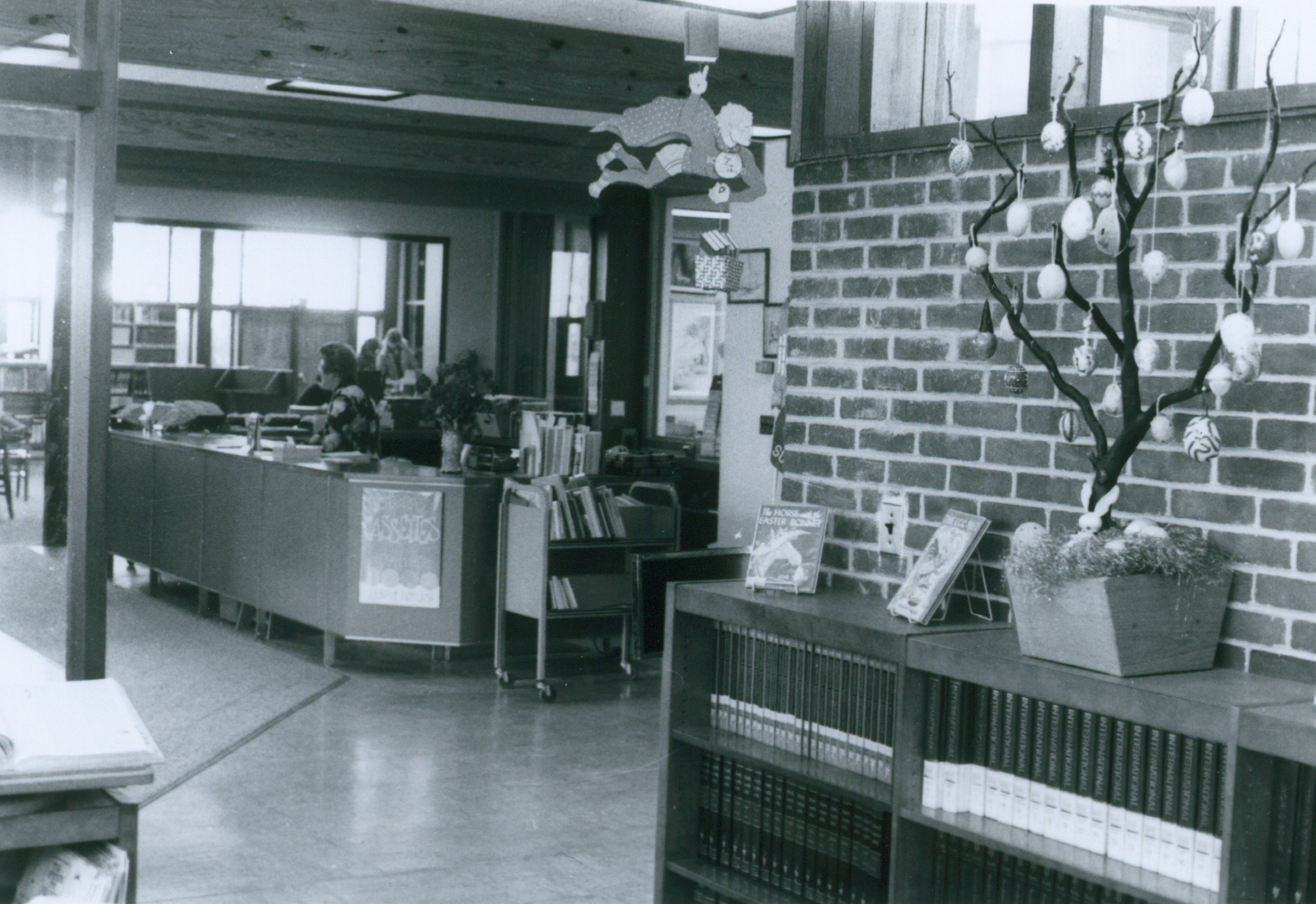
Circulation in 1978
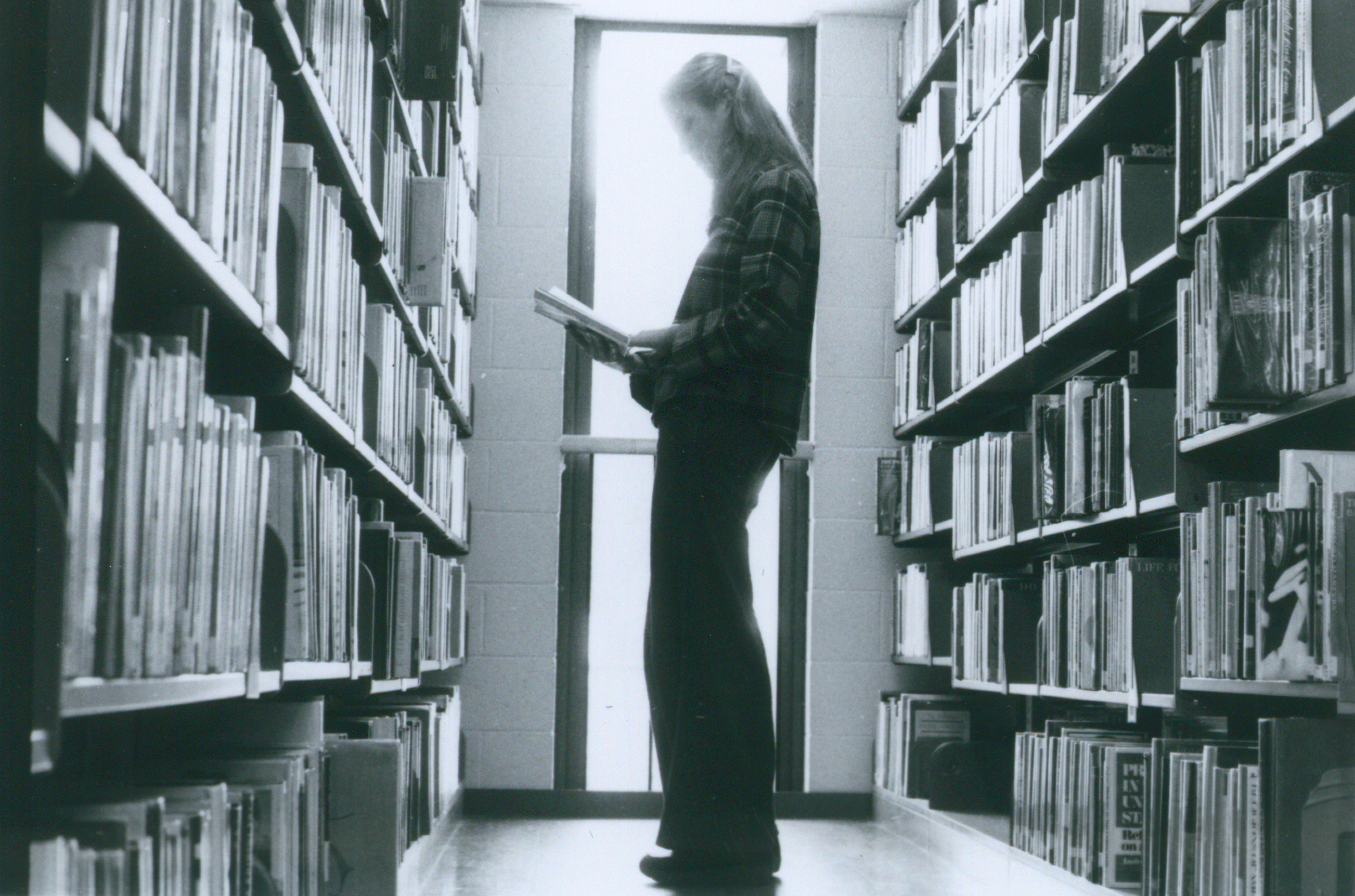
Visitor reading in the book stacks in 1978
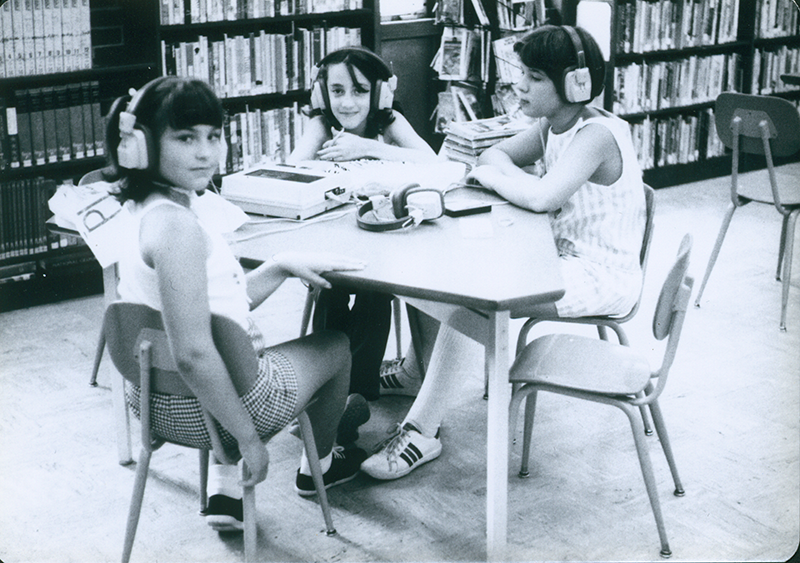
Kids listening to audiobook in 1979
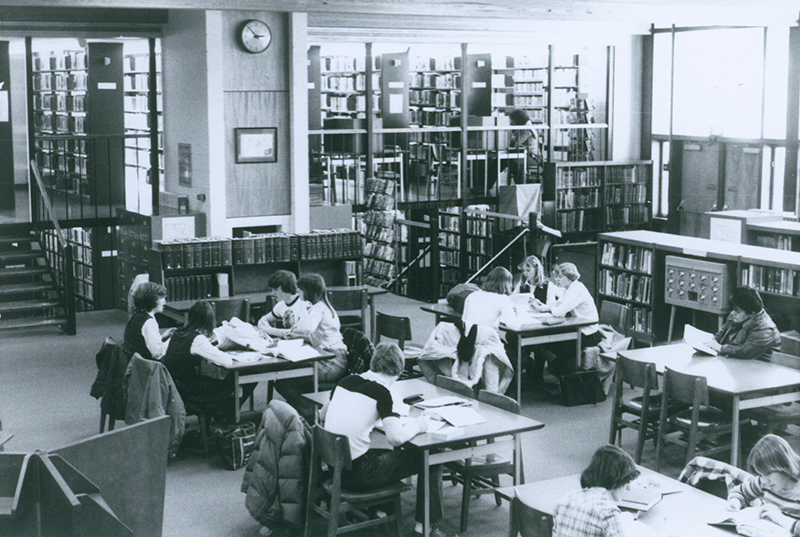
Reading Room, 1979
The new Library opened on May 7, 1966 with a Cornerstone laying ceremony headed by John P.G. Bates, then President of the Library Board. Mrs. Charles H. Huntoon, long-time member of the Board, read a brief history of the organization...The new construction featured split level multi-tier stack areas with electric book lifts at each end separated by a central adult reading area at street level which attached to the existing children's wing. The large reading/reference room had six four-unit study carrels, handy reference shelves, an adjacent meeting room backed up by offices and the circulation desk and entrance/exit. Two small buildings ("gazebos") had been added to and connected with the children's section by a glass-walled corridor overlooking a small courtyard; one housed stacks for children's books and the other was designed for story-hours but also had peg-board walls for possible displays. Beneath the main building, there was also a full basement for utilities and storage and, on the south side, a small parking lot. Staff numbered seven full-time and seven part-timers, ten pages and twelve aides. During the summer, eight college students were added to assist with the seasonal reading programs. The new construction increased the library's book capacity from 41,000 to 78,536; it also increased floor space to 12,000 square feet providing seating space for about 100 people. In 1983, the "gazebos" were demolished and an addition to the building to be known as the Elinor Haff Wing replaced them. It included a significant expansion of the Children's Section, a small meeting room and several offices and increased the present available area to 14,200 square feet; it was dedicated on November 17, 1985. In the fall of 1999, the Library joined PALS (Partnership of Automated Libraries in Suffolk County) and began conversion to an updated automation system; a major advantage was that if borrowers could not find what they were searching for here, they could check on line and find another library that could provide it. At that time, the building was again "busting at the seams". The Library had a collection of about 100,000 books, 15,000 audio/visuals and 5,000 periodicals; its attendance had jumped by over 77% in the last five years; and its 55-seat, 500 square foot meeting room was playing host to many from among 170 local groups. As an aid in future planning, at the end of the year a questionnaire was sent to about 1,000 local residents inquiring as to how they were using the Library, what services and programs they would like to see, etc .In November 2000, the then current collection of 125 historic postcards was put online to help students and local historians link the past with the present; this was the nucleus of the expanded Sayville History image collection that you are viewing now.
By the last quarter of 2001, the Library had developed tentative plans for a new two-story and basement 37,000 square-foot building to replace the existing one on the same site. (The existing building could not support a second floor and exploration of other sites - particularly for much needed additional parking area - had been unsuccessful) There was immediate voter concern with the estimated $10-13 million cost, the location and the "need". Two months later, the School District offered a possible site on Greene Avenue on the former location of Old '88. However, the proposal was defeated by the voters in April 2002. That year, the Library received 323,000 visits (up from 195,000 in 1995) and 13,300 had attended 730 in-house community programs of various types (up from 7,000 at 500 in 1995). After being "streamlined", a second scaled down proposal for a building at the Greene Avenue site was submitted to and rejected by voters on March 11, 2003. Where to from here? Over 90 years, the Sayville Library had grown from a small local facility to a major lending library with a broad collection of over 150,000 books, publications, CDs, DVDs, videotapes and extensive computer software, as well as becoming a community center providing computer use and hosting organizational meetings and entertainments. It was on a small piece of ground with an 18-vehicle parking lot, had no room for further expansion and did not meet the current building codes, most notably those in accordance with the Americans with Disabilities Act. In 2004, Friends of the Library aggressively initiated an awareness program concerning needs of the Library and the Library Board reviewed four new renovation or construction proposals, each with an eight-million dollar cap. On November 13-14 that year, the Library celebrated its 90th year, making available to its patrons a guided History Trolley Tour of Sayville and West Sayville, a flip-book with photos of some of the sites seen en route and games, music and refreshment at its headquarters. Nevertheless, the inability of the organization to fulfill the community's apparent needs and requests without a new and larger building perpetuated and by September 2006 the Director and the Board of Trustees decided that the time had come to revisit the problem. They sought a $12,988,600 bond to construct a new building on the 1.38 acre site of "Old '88" on Greene Avenue. On November 1, 2006, about 1,000 more voters turned out than had appeared at either of the two previous bond votes and they approved the issue by a narrow 1,676 to 1,628 margin.
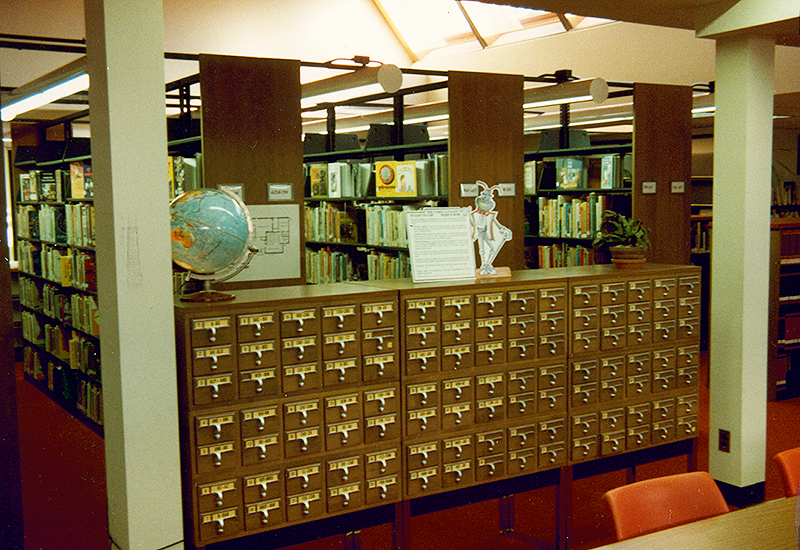
Card Catalog, 1985
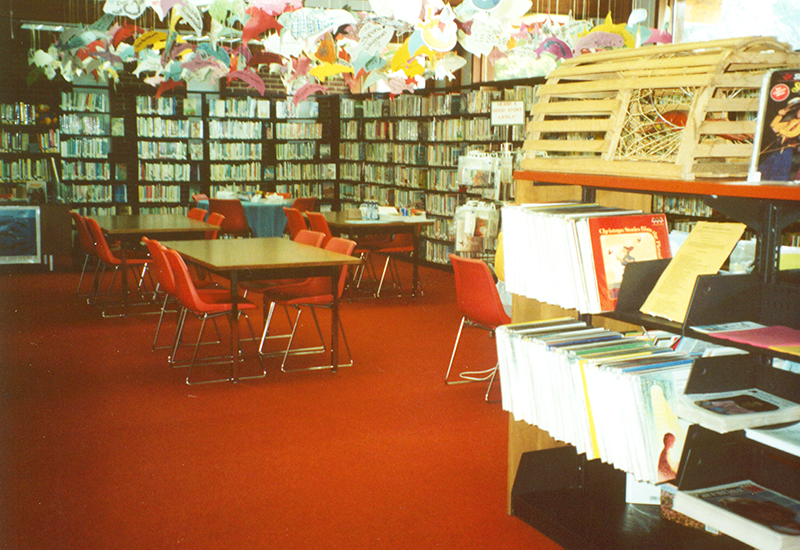
Children's Room, 1991
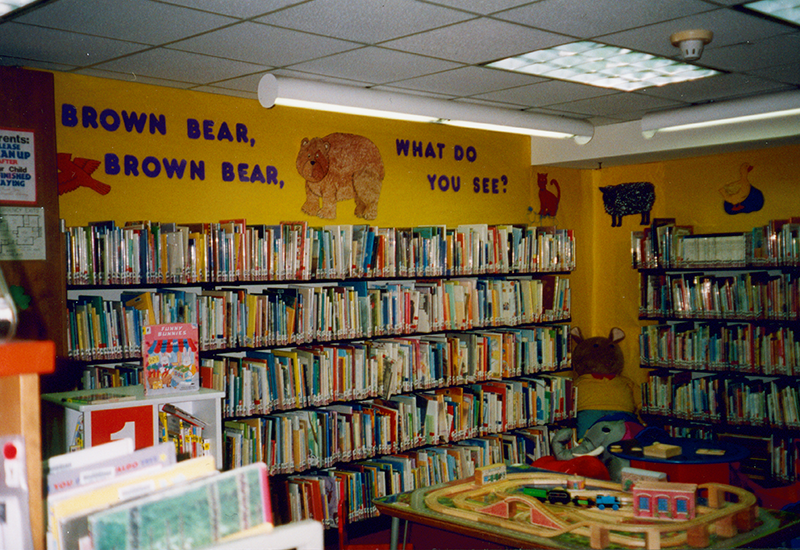
Children's Picture Books, 1999
On June 28, 2009, after Sayvilleites lined the streets connecting the old Library on Collins Avenue with the new one on Greene by hand-to-hand passing of one book, A History of Early Sayville, from one to the other, they came together at the site of "Old '88" to welcome the new Sayville Library. Following a brief ceremony and ribbon-cutting, residents entered the 39,000 square foot building for orientation tours and musical entertainment. It has five levels (connected by elevator), two below ground and three above. The lowest public level houses two meeting rooms (one with a stage) and an art gallery; the next up, extensive Children's Services with an adjacent outside garden area for summertime story hours; then, mid-level, the main entrance, lobby and Circulation Services; above that is "Teen Central", designed especially for young adults, with computers, desks and easy chairs; lastly, the top level, stretching the full length and width of the building, is devoted to Adult Services with extensive stacks, a quiet reading room, a computer room, private study rooms, and the Long Island Room and vault, devoted to history and genealogical publications, films and maps. For improved efficiency, the new building also features solar panels on the roof and a geothermal energy system, both partially funded by State grants. At present (2014), the Sayville Library collection has about 175,000 items, including about 147,000 books; it is visited by 14,744 borrowers with Library cards out of 18,500 population served and it has about 70 employees.
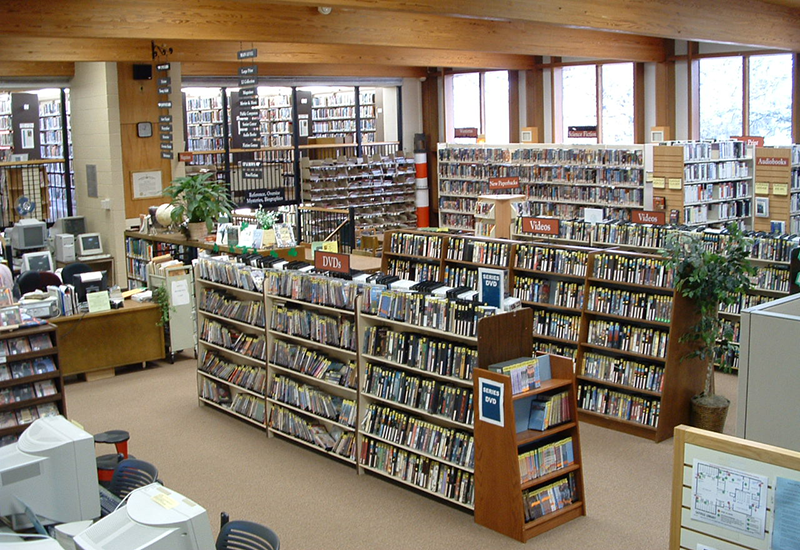
Adult Services, 2006
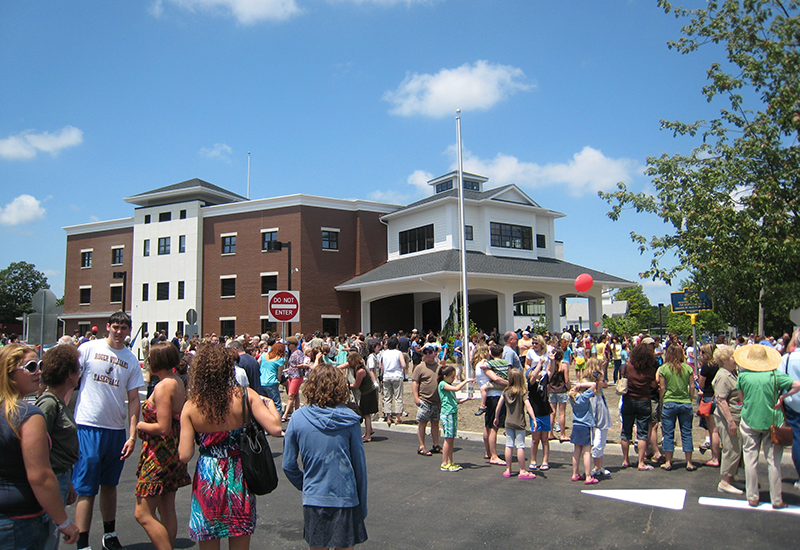
Grand Opening on Greene Avenue, 2009
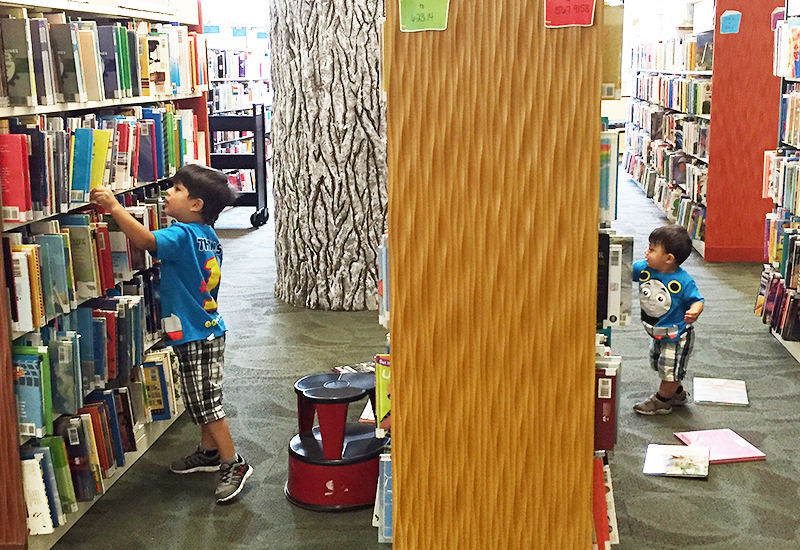
Children's Room, 2016
For further details, see: Lisa Lukoski, A History of the Sayville Library From 1914 to 1967. Brookville, NY: 1968
Constance G. Currie: My Days at the Library 1961-1968. Sayville, NY: 2004
All images from collection of Sayville Library